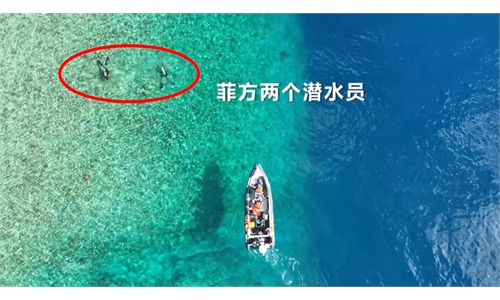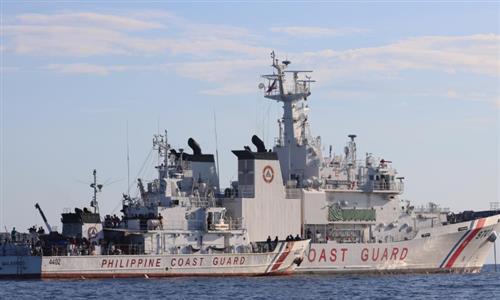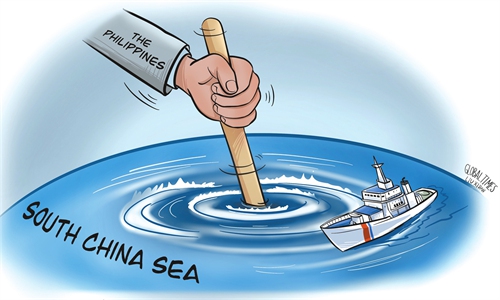Experts warn Philippine vessel moored at Xianbin Jiao discharging excessive sewage, causing damage to corals
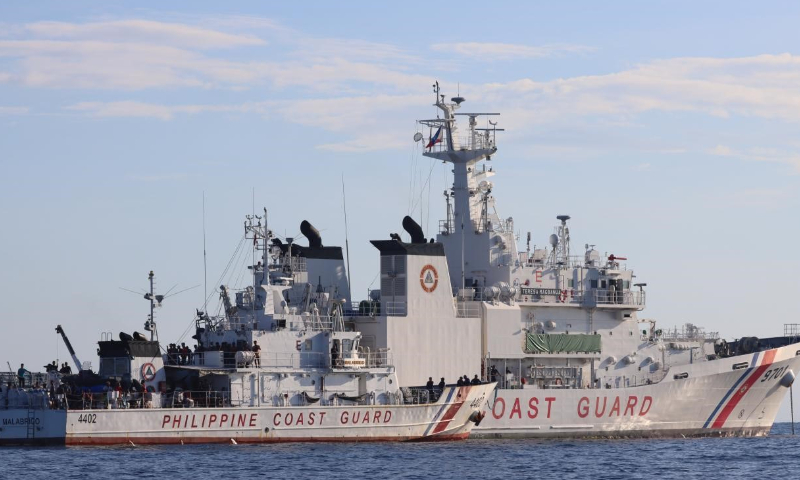
The photo taken on May 6, 2024 shows the Philippine ships 4402 and 9701 are transferring supplies in the waters of China's Xianbin Jiao. Photo: China Coast Guard
The Philippine Coast Guard (PCG) vessel, which was sent to "prevent China from reclaiming land," has been anchored in China's Xinbin Jiao's lagoon for over 120 days, trying to recreate the drama of the ship illegally grounded at China's Ren'ai Jiao.
As the PCG's largest vessel, its large and long anchor chain has been scraping the lagoon floor since mid-April, causing concerns of significant damage to the coral reefs. This prolonged anchoring may have led to serious coral death over the last four months, experts warned.
The vessel has surpassed its maximum anchoring time and is discharging more waste than it can handle, posing a major threat in terms of water pollution, they noted.
Experts question what would happen to the beautiful Great Barrier Reef, the world's largest coral reef system, if a ship were to anchor there for a longer time.
They urge the international community to pay attention to the potential irreversible harm caused by the Philippines' attempt to illegally occupy China's islands and reefs.
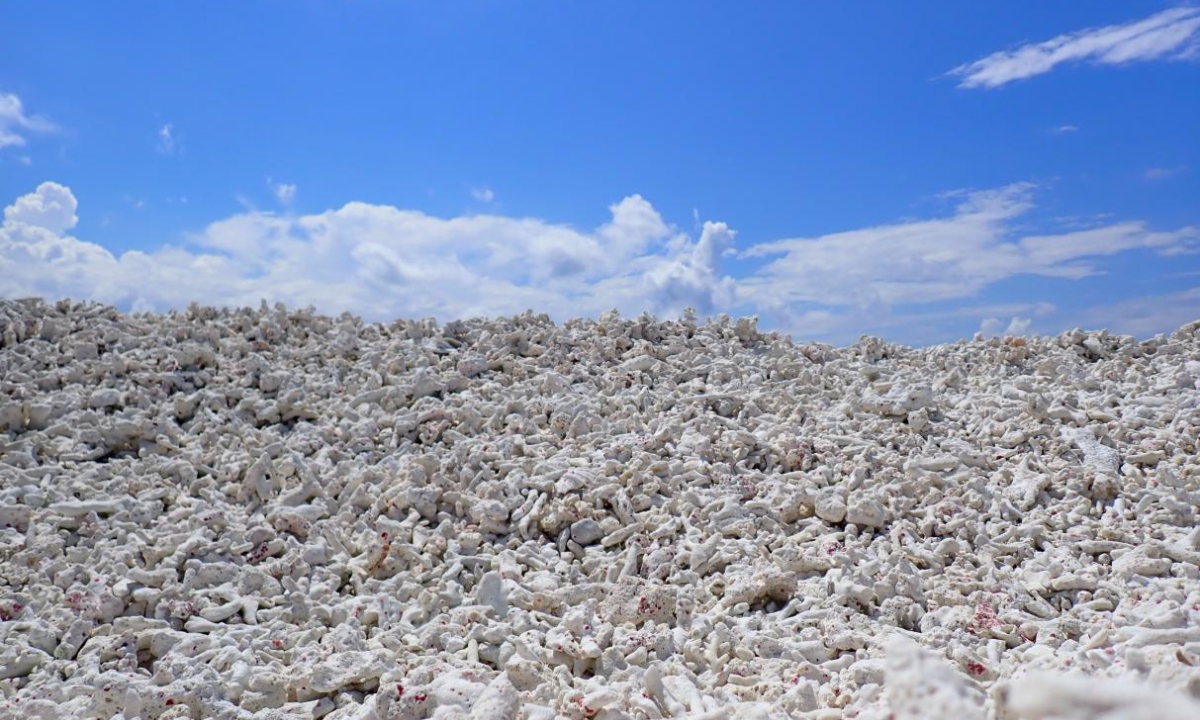
Biological debris distributed on a sandbar of Xianbin Jiao Photo: Courtesy of China's Ministry of Natural Resources
Damage to coral reefs
A large number of international academic studies have shown that anchoring can cause biologically significant damage to coral reefs. For example, when scientists performed a survey of 24 sites in the British Virgin Islands (BVI) in 2019 to assess the impact of varying levels of anchoring activity, they found that hard coral colonies were 40 percent smaller in surface area and about 60 percent less dense at sites experiencing high anchoring frequency, an academic paper published on the journal PeerJ in 2019 shows.
Another research activity carried out in the Florida Reef Tract found that anchors and chains from commercial shipping, fishing, and recreational vessels can break or dislodge corals, sponges, and sea fans, resulting in immediate and long-term damage to large areas of the coral reef.
Since some species of coral grow only one centimeter per year, it can take many years to recover from an anchoring incident. Anchoring also causes immediate and extensive damage to reef-associated habitats such as seagrass beds, which are important nursery and juvenile habitats for many species.
Sun Jianxiang, a maritime studies scholar at the Institute of Maritime Strategy Studies, China Institutes of Contemporary International Relations, told the Global Times that the PCG vessel BRP Teresa Magbanua (MRRV-9701) can damage coral reefs when its anchor and anchor chain sweep the corals during long periods of "grounding" at the lagoon at China's Xianbin Jiao.
In December 2015, the MV Zenith, a luxury cruise ship encroaching on a protected coral reef in George Town, Grand Cayman, alarmed the public and raised widespread concerns when an underwater video camera recorded its anchor chain "draped across the entire reef, constantly moving back and forth across the reef and causing a lot of damage as it did that," Quartz, an American English language news website, reported.
"It's not hard to imagine the extensive damage caused by a PCG ship mooring around on a coral reef for over four months. Studies have shown that coral reefs damaged by anchors may never fully recover, and if they can be recovered, it could take up to 50 years," said Sun.
Yang Xiao, deputy director of the Institute of Maritime Strategy Studies at the China Institute of Contemporary International Relations, explained that the shallow waters of Xianbin Jiao's lagoon, combined with the forces of waves and sea winds, intensify the impact of the ship's anchor on the coral, posing a threat to the underwater ecosystem.
"Normally, ships don't anchor in the lagoon unless faced with dangerous sea conditions. The destruction of coral reefs can lead to the loss of marine life habitats, ultimately disrupting the entire ecosystem," Yang told the Global Times.
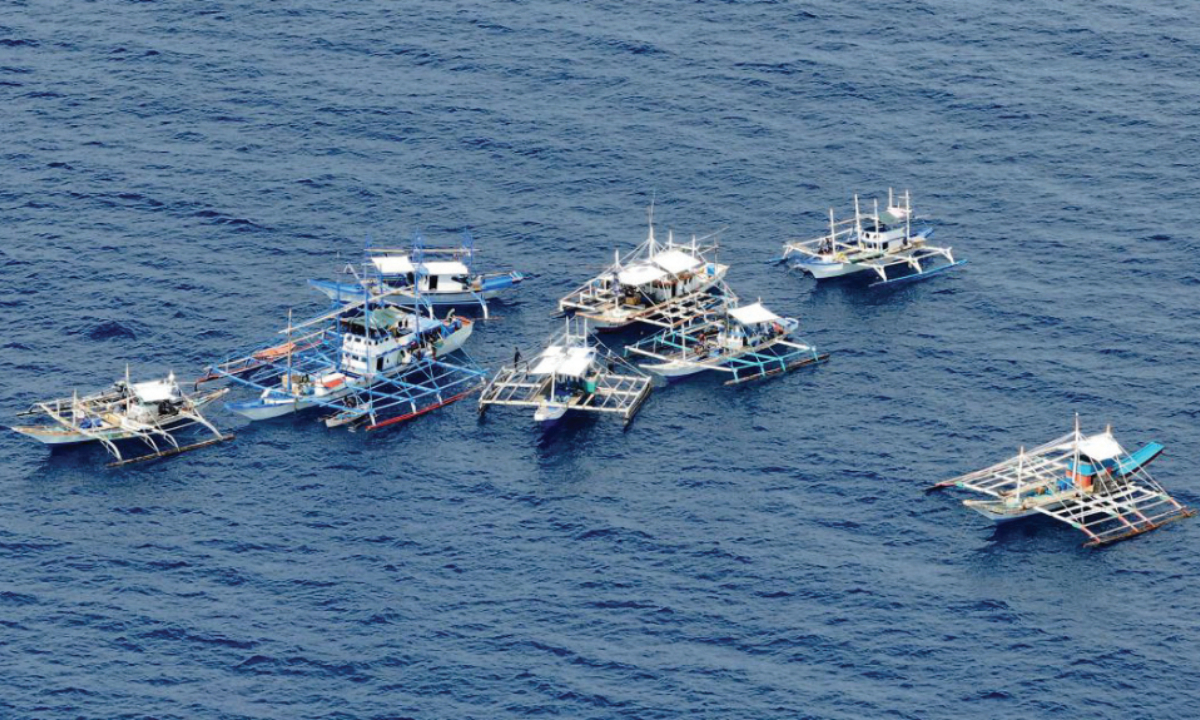
Filipino fishing boats on the northwest side of the lagoon of Xianbin Jiao Photo: Courtesy of China's Ministry of Natural Resources
PCG ships pollute seawater with man-made garbage
The BRP Teresa Magbanua's waste disposal capabilities do not seem to support its long-term anchoring at sea, experts pointed out. BRP Teresa Magbanua participated in the Regional Maritime Pollution Exercise (MARPOLEX) 2022 in Makassar, Indonesia in May 2022 with another ship BRP Melchora Aquino. Both vessels, according to Eduardo Fabricante, PCG Deputy Commandant for Operations, would be deployed to the West Philippine Sea and the Philippine Rise. "This is to increase the endurance and patrol capabilities of the PCG as the said capital ships can remain at sea for up to 14 days," the PCG said.
Now this ship has far exceeded its endurance, which means its capacity for discharging garbage and sewage has far exceeded what it can carry, Sun suggested.
Based on the project profile released at the PCG's website, it is estimated that the maximum capacity of the sewage tank of BRP Teresa Magbanua is 69m³. Roughly estimated, even if the ship carries half of its passenger capacity (designed for full capacity of 67 crew members), it would produce approximately 163.3m³ of black water and 327.5m³ of grey water in two months, far exceeding its designed sewage treatment capacity.
The onboard ship sewage system is divided into two parts - black water and grey water. Black water is wastewater that originates from toilets and contains human waste (excrement and urine). This water typically goes to the sewage treatment plant and is stored in dedicated holding tanks on the ship until it can be properly treated and discharged in accordance with international regulations. Grey water is wastewater generated from sources other than toilets. It includes water from sinks, showers, baths, laundry facilities, and galley sinks.
Dubbed as "the largest and most advanced ship in the PCG's fleet," the BRP Teresa Magbanua has not been in service for very long and has shown no signs of upgrades between 2022 and 2024. The Philippines lacks the capability and technology for such upgrades, which is why they purchased the vessel from Japan. The ship relies on other vessels for resupply and is unlikely to make additional efforts to protect the environment by properly disposing of its waste. It is highly possible that crew members at the ship simply dump their garbage and sewage directly into the lagoon, similar to the illegally grounded vessel BRP Sierra Madre at China's Ren'ai Jiao, Sun explained.
The Philippines has long been notorious for marine water pollution. An international study, conducted by Utility Bidder, an independent UK-based organization and published on its website in October 2023, has shown that the Philippines is the world's leading contributor to plastic pollution in the oceans.
"It can be said that whether in the domestic or international environment, the Philippines has a relatively low environmental awareness when it comes to protecting water sources," Sun noted.
The Philippines' accusations against China for damaging coral reefs' ecosystem are just a cover for its illegal occupation of islands and reefs under the guise of so-called environmental protection issues. The international community should see through the true nature behind its 'environmental blame game,'" said Sun.
In the situation where its supply and evacuation capabilities are severely inadequate, the Philippine Coast Guard ship is still anchored at Xianbin Jiao, waiting for other coast guard ships or airdropped supplies. This clearly indicates their attempt to occupy Xianbin Jiao through illegal grounding, similar to its attempt to occupy Ren'ai Jiao, said Sun.
"Despite this, the Philippines continues to boast about achieving a so-called 'victory' and launch smear campaigns against China, which is truly a shameless and self-directed farce," Sun noted.

